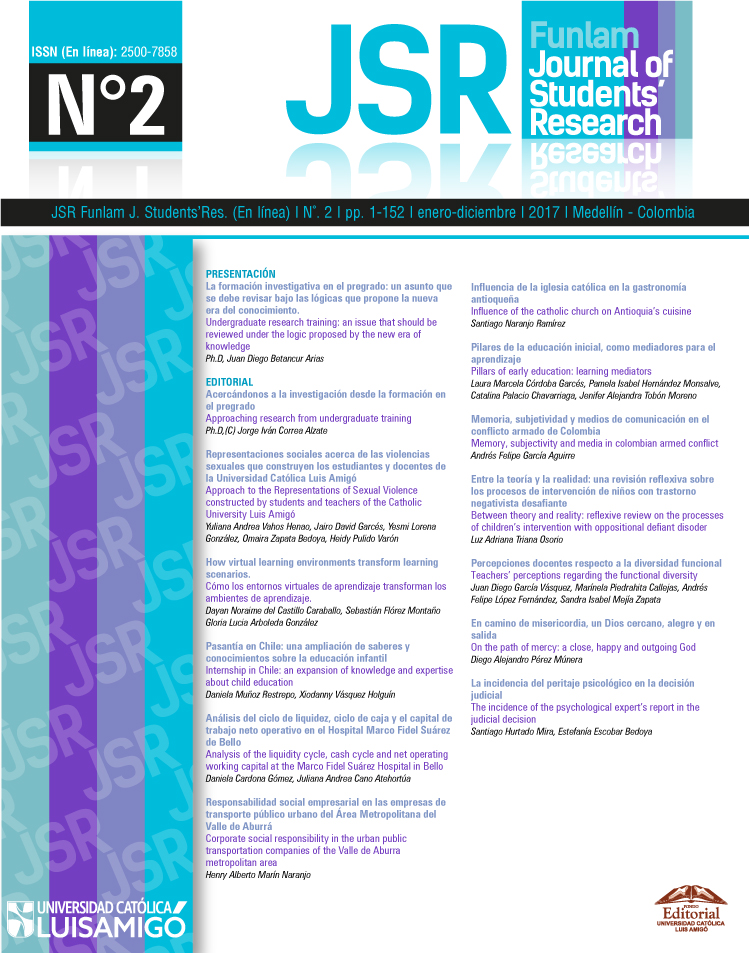How virtual learning environments transform learning scenarios
DOI:
https://doi.org/10.21501/25007858.2577Keywords:
Competences, Asynchronous interaction, Synchronous interaction, Technological integration, Virtual learning environment, Virtual learning object.Abstract
Technology integration in the classroom is an ongoing process where students and teachers modify their interaction and roles. In this integration, technological devices and virtual resources are used to achieve better educational purposes and enhance its processes. Additionally, through technology integration different skills needed in this century can be actually developed. Nowadays, teachers are implementing virtual scenarios in function of the learning process, like an option to integrate traditional education with progressive technology that society has used to impulse social, economic and cultural relations. This strategy has shown a variety of benefits in educational environments; however, it has been garbled by social and curricular barriers that limit the benefits of the use technology in education. This article includes some factors that make technology integration a way to revitalize traditional education, it also mentions why this integration is a successful strategy to improve the teaching and learning processes, to generate new knowledge and to enrich existent information.Downloads
References
Arkorful, V., & Abaidoo, N. (2015). The role of e-learning, advantages and disadvantages of its adoption in
higher education. International Journal of Instructional Technology and Distance Learning, 12(1), pp.29-42. Retrieved from: http://itdl.org/Journal/Jan_15/Jan15.pdf#page=33
Castells, M (1995). La ciudad infomacional: tecnologías de la reestructuración económica y proceso urbanoregional, Madrid: España:Alianza Editorial. Retrieved from http://e-tcs.org/wp content/uploads/2017/03/Castells_19951.pdf
Dias, L. B. (1999). Integrating Technology. Retrieved from: http://www.tangischools.net/TangiTech1/documents/integrating%20technoogy.pdf
Dillenbourg, P., Schneider, D., & Synteta, P. (2002). Virtual learning environments. In 3rd Hellenic Conference”Information &Communication Technologies in Education” (pp. 3-18). Kastaniotis Editions, Greece.
Galvis, H. A. (2012). Understanding Beliefs, Teachers’ Beliefs and Their Impact on the Use of Computer Technology. PROFILE Journal,14(2), pp. 95-112. Retrieved from: http://www.revistas.unal.edu.co/index.php/profile/article/view/34062/34195
Fox-Turnbull, W. (2010). The role of conversation in technology education. Design and Technology Education, 15 (1), 24-30.
Hrastinski, S. (2008). Asynchronous & synchronous e-learning. EDUCASE Quarterly, 31(4), pp. 51-55.Retrieved from: http://net.educause.edu/ir/library/pdf/eqm0848.pdf
Lee, A. Y. (2014). Media Literacy and Information Literacy: Similarities and Differences/Alfabetizaciónmediática y alfabetización informacional: similitudes y diferencias. Comunicar (English edition), 21(42),pp. 137-145. Retreived from:http://search.proquest.com/openview/ef3cd9a25ee1846146620b6663c76bf/1?pq-origsite=gscholar&cbl=1206336
Lee, A. and So, C. (2014). Media Literacy and Information Literacy: Similarities and Differences. Comunicar,
(42), pp.137-146.
Lorenzo, G., & Ittelson, J. (2005). An overview of e-portfolios. EDUCASE Learning Initiative, Retrieved from
http://www.case.edu/artsci/cosi/cspl/documents/eportfolioEducausedocument.pdf
Ministerio de Educación Nacional (2013). Competencias TIC para el desarrollo profesional docente. Retrieved fromhttp://www.colombiaaprende.edu.co/html/micrositios/1752/articles-318264_recurso_tic.pdf
Morton, C. (1996). The Modern Land of Laputa: Where Computers Are Used in Education. Retrieved from https://www.questia.com/library/journal/1G1-18084237/the-modern-land-of-laputa-where-computers-are-used
Pacific Policy Research Center (2010). 21st Century Skills for Students and Teachers. Honolulu: Kamehameha Schools, Research & Evaluation Division
Partnership for 21st century learning (2016). Framework for 21st century learning. Retrieved from: http://www.p21.org/our-work/p21-framework
U.S. Department of Education, National Center for Education Statistics (2002). Technology in Schools:Suggestions, Tools, and Guidelines for Assessing Technology in Elementary and Secondary Education.
Retrieved from https://nces.ed.gov/pubs2003/2003313.pdf


